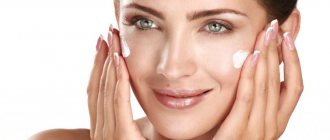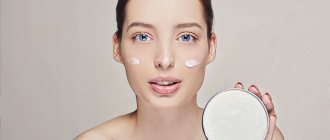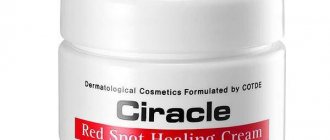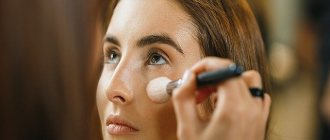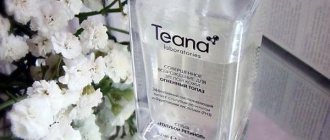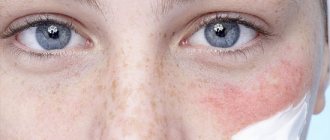From this article you will learn:
- What you need to know before determining your skin type
- 5 ways to determine your facial skin type at home
- How to visually determine your facial skin type
- What other skin type can be determined?
- How to determine your facial skin type by using a cosmetic wipe
- How to determine your skin type: a 6-question test
- How to not only determine your skin type, but also identify the first signs of aging
- How to correctly determine your body skin type
- How to determine your scalp and hair type
- Care after determining your skin type
The question of how to determine skin type is important for those people who care about their appearance and health. Due to differences in skin types, people react differently to the same products, which means they need an individual approach. We will try to figure out how to correctly determine the type of facial skin and what are the characteristics of each type.
What you need to know before determining your skin type
There are four main skin types:
- Normal;
- Fatty;
- Dry;
- Combined.
There are various characteristics
these four types, on the basis of which specific options for care and care are selected.
Normal skin
– this skin type is determined by its pH level of 5.5. She looks healthy and has the usual small pores. With the right care, the likelihood of wrinkles appearing will be minimal. Normal skin has the right balance of oil and moisture, which reduces the tendency for irritation to occur.
Oily skin
refers to a certain skin type, which is characterized by an oily sheen and enlarged pores. This is a consequence of increased secretion of the sebaceous glands. The average pH level is 6. The advantage of this skin type is that the abundant fat layer prevents the skin from drying out and, as a result, the appearance of wrinkles.
Dry skin
. This skin type can be determined by the following indicators. Unlike oily skin, it has a small number of fat cells, which contributes to the formation of wrinkles. Wrinkles appear most quickly in the area around the eyes. Dry skin is most often observed in women over 50 years of age and in people who have lived for a long time in a dry – either hot or cool – climate. This skin type is characterized by small pores and a dull skin tone.
You can determine dry facial skin type by certain signs. For example, roughness of the skin, peeling and cracks. All this can occur as a result of inadequate care and protection from frost and sun, insufficient hydration and fluid intake. pH from 3 to 5.5. The listed signs of dry skin type speak not so much about a person’s tendency to allergies, but about the sensitivity of the skin.
Combination skin
- a certain type of skin, the pH result of which depends on specific areas: dry - with an indicator of 3, oily - with an indicator of 6. Combination skin combines dry and oily skin types. Dry skin may appear in areas such as the cheeks, temples and eye area. Oily – on the forehead, nose and chin. The main differences between combination skin type are a healthy appearance, large pores in certain areas, uneven color, and with proper care, a minimal likelihood of wrinkles appearing.
Skin sensitivity
But any skin, regardless of age and type, can have such a characteristic as sensitivity.
Increased skin sensitivity can be temporary - caused by health problems, menopause, and certain cosmetic procedures, such as peels.
High sensitivity can also be permanent - due to certain genetic characteristics of the skin and blood vessels. This indicator also needs to be taken into account when choosing cosmetics.
How to visually determine your facial skin type
To visually determine your facial , you will need a clean face and good light.
How to determine your facial skin type.
First you need to inspect the surface using a magnifying glass. It is better to write down everything that was noticed, so that later, based on your observations, you can determine the type of skin on your face: dry or oily, normal or combination. The main features that you need to take a closer look at are the presence of oily shine, pimples, blackheads, wrinkles and cracks. It is also important to determine the size of the pores - large or small.
Recommended articles on the topic:
- How to properly care for your skin
- How to remove wrinkles on the face: the most effective methods
- Microcurrent facial therapy - a beneficial treatment for your skin
Normal facial skin type
characterized by the presence of such characteristics as cleanliness, freshness, lack of greasy shine, matte tint, elasticity and smoothness. Normal skin is rare and has the fewest imperfections, which is why everyone wants to have this type of skin. The only problem that those with normal skin face is the greater likelihood of dryness, as well as cracks and wrinkles as a person gets older. This is due to a decrease in the amount of sebum that is produced in youth. But these shortcomings can be prevented if you take proper care of your face from a young age.
Oily skin type. Oily facial skin type can be identified by such signs as acne, pimples, oily shine and large pores. Due to the abundance of fatty acids, wrinkles on the face appear quite late, and the skin continues to maintain elasticity and firmness. Oily skin needs special care. It is important to clean it properly using various masks and foams. You should also pay special attention to your diet. Eat more vegetables, fruits, dairy and fermented milk products. Do not use sauces and various additives, such as mustard, vinegar.
Dry facial is characterized by several problems. The environment has a great influence on it and worsens the condition of the skin. Dry skin may peel after contact with water. She is too delicate and thin and loses her beauty quite quickly.
Combined (mixed) facial skin type . Most people have this type. This is a combination of dry and oily skin. It is very easy to determine the mixed type. It shows up as an oily sheen on the nose and dryness in the cheek area. Such skin requires careful care, because acne, signs of allergies and irritation may appear on the face.
There are also several additional skin types:
Mature skin . It appears in older people. Signs of aging become noticeable on the face: sagging and dull skin. Various wrinkles can be seen in risk areas: on the cheeks, around the eyes, on the forehead.
Dry and sensitive . Fine-porous, velvety, peels off easily, prone to irritation and wrinkles, prone to allergies.
Oily and combination skin . This type of facial skin is determined by the presence of pimples, blackheads, oily areas of the face, and large pores.
Problematic (acne skin) . The most complex skin that requires special, constant and professional care. Using a standard set of cosmetics, it is impossible to cope with acne and pustular rashes that appear on problem skin.
Read material on the topic: Laser facial skin rejuvenation: useful tips and recommendations
Care - basic rules
There are recommendations both for specific types and general ones. For any skin, it is important to carry out daily care in three stages:
Cleanse. Washing with any product. Twice, morning and evening. Prepares the epidermis for the second stage. It is better to carry out with water at room temperature.
Tone. Residues of cleanser are removed and pores are narrowed. A tonic is used.
Moisturize. The cream is necessary to maintain the skin's natural moisture level. It is best to choose a cream with ultraviolet protection (SPF from 30).
What other skin type can be determined?
Many people believe that they have sensitive skin. But this type of skin does not exist; it is only possible in combination with other types.
This misunderstanding arises as a result of some of the materials published in thematic sources. Different systematic approaches determine skin types in their own way. For example, in Leslie Bauman’s classification there are 16 different options:
DRNT: dry, resistant to irritation, non-pigmented, smooth.
DRNW: dry, resistant to irritation, non-pigmented, prone to wrinkles.
DRPT: dry, resistant to irritation, pigmented, smooth.
DRPW: dry, resistant to irritation, pigmented, prone to wrinkles.
DSNT: dry, sensitive, non-pigmented, smooth.
DSNW: dry, sensitive, unpigmented, prone to wrinkles.
DSPT: dry, sensitive, pigmented, smooth.
DSPW: dry, sensitive, pigmented, prone to wrinkles.
ORNT: oily, resistant to irritation, non-pigmented, smooth.
ORNW: oily, resistant to irritation, non-pigmented, prone to wrinkles.
ORPT: oily, resistant to irritation, pigmented, smooth.
ORPW: oily, resistant to irritation, pigmented, prone to wrinkles.
OSNT: oily, sensitive, non-pigmented, smooth.
OSNW: oily, sensitive, unpigmented, prone to wrinkles.
OSPT: oily, sensitive, pigmented, smooth.
OSPW: Oily, sensitive, pigmented, prone to wrinkles.
An online test that determines skin type according to Leslie Bauman's classification is available on the Internet. For each option there is a special care kit. But to take care of your face, you don’t have to be a super specialist and understand all the classifications in detail. You can simply take care of your skin by first finding out which of the four main types it belongs to.
Additional problems
For cosmetologists, classification by type is not limited to the conclusions of the 4 varieties that we indicated above. They identify and define additional subtypes:
- Mature. Folds, wrinkles, and other changes characteristic of age are clearly visible - swelling under the eyes, ptosis. It can be determined by visual inspection.
- Problematic. Irritation, rashes, and acne often occur. It is also not difficult to determine.
- Cooperose. The pattern of capillaries is enhanced. Couperosis is characterized by a red, sometimes bluish tint.
- Sensitive. Reacts with inflammation to any external irritants.
A doctor can best tell you how to properly use cosmetics for pathologically altered skin. Amateur action in this area is undesirable - it can aggravate the situation. For example, women with rosacea cannot visit the bathhouse and sauna, use belongings, etc. But few people know about this, because they never reached a professional cosmetologist.
How to determine your facial skin type by using a cosmetic wipe
To determine your skin type, you need a cosmetic tissue (a simple paper one will not work in this case).
The procedure is as follows: first, let your skin rest for three to four hours. Then touch the napkin to the desired points: cheeks, forehead and chin. Check the marks left on the napkin. By their quality and quantity, you can determine your facial skin type.
If there is oily discharge all over your face, it means you have an oily type.
If there is fat only in the area of the forehead-nose-chin triangle, but not on the cheeks, then it is a combined type.
Normal skin: If there is some fat on the forehead and nose.
You have dry skin, if there are no oily stains on the napkin.
Features of applying makeup (4 tips)
Each representative of the fair sex has its own unique external features, but when choosing decorative cosmetics it is always necessary to be guided by the types of facial skin and their characteristics accepted in cosmetology:
- Women with a normal type rarely suffer from any problems, because almost any cosmetic product is suitable for them. There are no dry areas, oily shine or inflammation on the face. In makeup you can use both matte and pearlescent tones.
- Special makeup bases can help eliminate tightness and flaking of dry skin. The best option would be a base with a dense texture and reflective elements. Compact powder is suitable; loose powder is not recommended. The ideal blush is in the form of a mousse.
- For oily skin with shine, blackheads and inflammation, mattifying makeup foundations and powders with a loose texture are suitable.
- Girls with combination skin need to find the so-called “balance” of makeup. Each area of the face needs close attention and special care. To make your makeup last longer, you should always carry loose powder and a brush for applying it.
Each type of facial skin has its own characteristics and characteristics, which cannot but affect the process of applying makeup. It is important to take into account the listed nuances in order to always look great.
How to not only determine your skin type, but also identify the first signs of aging
The first signs of aging can be identified as follows: press your thumb into the center of the cheek and rotate. What's happening?
- If there is resistance, it means you are young and have no signs of aging.
- Wrinkles appear, radiating from the place of pressure - this indicates the first symptoms of withering.
- Sluggish skin with wrinkles indicates that the aging process is already underway.
What to do after determination?
The next step is to select care taking into account your skin type and other features. It is best if a care strategy is developed by a specialist who takes into account not only the degree of oiliness of the epidermis, but also other nuances. But the general direction of care can be determined independently.
It should be taken into account that:
- The more active the sebaceous glands are, the lighter textures should be used;
- Everyone needs hydration, but it is especially important to hydrate dry skin;
- Products for the care of oily skin contain anti-inflammatory additives, since increased oiliness of the skin is often accompanied by rashes;
- Absolutely everyone needs UV protection;
- Creams “for all skin types” are best suited for the care of normal skin; in other cases, it is better to give preference to products that meet the needs of your skin.
If you don’t have time to select cosmetics at random, or if you are unhappy with the condition of your skin, it is better to make an appointment with a cosmetologist and receive individual recommendations on self-care. This approach allows you to achieve the optimal effect, saving time and money.
How to correctly determine your body skin type
Normal
- Skin is normal after contact with water.
- In winter, the skin on your elbows, knees and feet can be dry.
- Resistant to any climatic conditions.
- Tolerates any type of cosmetics.
Dry
- The skin feels tight after contact with water.
- There are cracks and peeling.
- Elbows, knees and feet have roughness.
Sensitive
- Unresistant to weather conditions and some cosmetics.
- Dryness sometimes appears in some places.
- Recovery from cuts takes an extremely long time.
Dehydrated
- All areas are rough.
- Skin tone has decreased.
- Unpleasant roughness everywhere.
It is almost never possible to determine the type of body skin and obtain accurate data, because the skin is constantly exposed to many factors. In addition to the environment and climate, clothing has a big influence on it. Low quality shoes and the fabrics you wear can cause irritation and itching all over your body.
Therefore, to determine your body skin type more accurately, it is better to see a doctor. There, your skin will be examined using a special apparatus and they will give you advice on how to care for it and what cosmetics you can use. Some women have similar devices at home because they are easy to use.
Pay close attention
It is possible to incorrectly determine the type of body skin due to another circumstance: some women do screening tests at a time when their skin is subjected to improper care and symptoms of a disease that are not typical for it appear on it. These symptoms may be temporary, but they will cause false results when determining your skin type.
For example, a situation may arise when a woman comes to a cosmetologist complaining about problems with oily skin. And this is just the result of the fact that she used the wrong cream, which caused increased work of the sebaceous glands. Although by nature she has a dry type. How to accurately determine your skin type in such a situation? This should be done by a specialist. At home, you won’t get the right answer, and all attempts to correct the situation can lead to even bigger problems.
Soon the oily skin will disappear on its own. The sebaceous glands will stop producing fat, because its reserves are not unlimited. As soon as all the fat deposited by nature comes out, the woman will discover that her skin type is dry or sensitive.
Definition
Skin is the outer covering that serves as a barrier between the body and the environment. This is an organ that has its own blood supply, innervation (trigeminal nerve), and diseases. The skin consists of
- Epidermis.
- Dermis.
- Hypodermis.
The epidermis is the upper epithelial cover, consisting of several layers. Constant renewal of the skin occurs thanks to the lower. It consists of cells that divide intensely or not very much. Thanks to this, the skin is regularly renewed. On the surface of the epidermis there are keratinized cells. They protect the skin from damage and exfoliate.
The younger the skin, the more intensely it renews itself. Newly formed cells push out old ones. If the keratinized particles are layered, the process of cell division slows down. The condition of the epidermis is also affected by the amount of water you drink per day. It is what increases the elasticity of the skin.
Anatomy of human skin (clickable image)
There are no blood vessels in the epidermis. They are in the dermis. In addition, it contains hair follicles, nerves, sweat and sebaceous glands. The hypodermis is a fatty layer that protects against excess heat and cold.
The smaller the fat layer, the more wrinkles.
How to determine your scalp and hair type
How to determine your scalp type? It is inseparably associated with the type of hair; they are interconnected with each other. Therefore, you can determine your scalp type based on the distinctive features of the hair itself.
| Hair type | Normal | Fat | Dry | Mixed (oily at the roots, dry at the ends) |
| Need for washing | Every 2 – 3 days | Daily | Once a week | Every 2 – 4 days |
| Scalp, hair roots | After washing they are normal, after a couple of days they are oily | After washing they are normal, in the evening of the first day or in the morning of the second they are oily again | After washing - dry or normal, 3-4 days - normal, by the 7th day - oily | After washing they are normal, after 2-3 days they are oily |
| Tips (with medium hair length) | Normal or slightly dry, may irritate a little | No splits or almost no splits | Dry, brittle, may have a lot of broken or split ends | Dry, split ends |
| Shine | After washing - clean shine, after 2-3 days - greasy shine at the roots | Clean shine after washing, greasy shine by the end of the first day or the morning of the second | After washing there is a slight shine, then the hair becomes dull | After washing, there is a clean shine at the roots, a slight shine at the ends. On days 3-4 – oily shine at the roots and lack of shine at the ends |
| Splendor and volume | Normal fullness | Only immediately after washing or not at all | Reinforced | Medium, ends may get frizzy |
| Electrification | Sometimes | Very rarely | Often | Maybe at the ends |
| Styling without styling products | Gives in well | Hair can be styled, but it doesn't last long | Poor styling | Root styling |
How to care for oily skin
In people with such skin, the sebaceous glands work too actively. Therefore, a few hours after washing, the face begins to shine. Pores, especially in the forehead, nose and chin area, are enlarged. Pimples and blackheads are not uncommon.
However, oily skin has a huge advantage: it ages slower. The secreted sebum creates a good protective film that prevents moisture from evaporating and blocks the penetration of harmful substances from the outside.
Cleansing
- Wash your face morning and evening. For deeper cleansing of pores, you can use a special brush or sponge.
- Do not often use super-strong facial cleansers: there is a risk of drying out the skin. In response to aggressive influence, the sebaceous glands will begin to work even more actively.
- Don't squeeze pimples. Inflammations can be spot-treated with alcohol, salicylic acid solution or tea tree oil.
- You can use exfoliating products once or twice a week. It is best to use scrubs or peels in the evening after washing your face.
- At the end of washing, rinse your face with cool water. Under the influence of cold, pores shrink, become less noticeable, and the face becomes less shiny throughout the day.
Care
- Instead of thick creams, choose light moisturizing emulsions, gels or lotions.
- Make masks no more than three times a week to cleanse the skin, tighten pores and relieve inflammation.
- Don't forget about moisturizing: it is enough to apply softening masks once every one to two weeks.
- Good components of a mask for oily skin would be weak acids (freshly squeezed lemon or berry juice) and antibacterial agents (honey, tea tree oil).
Homemade mask recipes for oily skin:
- Protein mask. Beat the egg white into a strong foam and mix it with ½ teaspoon of lemon juice. Keep on your face for 15–20 minutes. This will tighten the pores and remove oily shine.
- Kefir mask. Apply kefir or yogurt to your face with a cotton swab and leave for 15–20 minutes. This will dry out oily skin.
- Tea mask. Grind 5 tablespoons of leafy green tea into fine dust and mix with 2-3 tablespoons of kefir. Apply the mixture for 10–20 minutes, and then rinse with warm water.
Decorative cosmetics
- Choose powder or light liquid foundations. Don’t make a “layer cake” on your face: this will not get rid of oily shine, but will only pollute and weigh down your skin.
- To eliminate oily shine during the day, use mattifying wipes. Or simply press a thin paper towel lightly onto shiny areas, then re-powder as needed.
Care after determining your skin type
Normal skin
Proper care of normal skin will help keep it healthy for many years. Take care of it, because normal skin is extremely rare today. You need to determine for yourself how to properly care for it and, most importantly, how to prevent drying out. Do not expose your skin to sunlight for a long time. Also, eau de toilette, which contains a large amount of alcohol, is contraindicated for her. All these negative factors can have a harmful effect on the condition of the skin.
Morning care for normal skin.
With a normal type, there are very specific recommendations that must be followed every morning to maintain the health and beauty of the skin. After you wake up, refresh yourself with cold water. If you determine that the water is not completely soft, dilute it with brown soda or baking soda. This will make the water softer and more pleasant to the skin. Next, you need to wash with soap. Apply eau de toilette with up to 15 percent alcohol to your face using a napkin. It is better to complete your morning routine with cream: for normal type, a hydrating or semi-oily cream is suitable.
Evening care for normal skin.
It is important for yourself to determine how to care for tired skin in the evening. At the end of the day, your skin needs some TLC too. After a day's work, the face is cleansed with cream or special milk, then wiped with eau de toilette. The nourishing cream is applied in this way: squeeze a little cream onto the fingertips and lightly touch the surface of the face.
Every week you need to make special masks. They may be different. The best option is to mix the yolk with vegetable oil or honey. You can also apply wrap masks.
Visiting beauty salons to care for dry and normal skin.
If you have determined that you have a normal skin type and want to take care of it at a more professional level, then you can go to special salons. For example, the city beauty and health center Veronika Herba in Moscow provides similar services. In the salon you will be examined and the best option for proper care of your skin will be chosen. Girls aged 18-25 years are recommended to undergo atraumatic cleaning once every six months. Massage or spa treatments are also possible, which will result in increased blood flow and smoothing of facial wrinkles.
Dry skin
Dry skin
fits into the category of a problem type, which is important to identify in time and begin proper care. Otherwise, the skin will begin to age and fade quickly. There are some factors that significantly reduce your chances of staying young and beautiful forever. It is very simple to identify them: look at the condition of your skin after prolonged contact with such things as direct exposure to sunlight, a quartz lamp, eau de toilette with a large amount of alcohol, low-fat creams, very cold or, conversely, hot water. In general, anything that dries out the skin is extremely contraindicated for people with dry skin types.
Morning care for dry skin.
Here is a rough diagram of what to do in the morning.
- Wash with warm water or chamomile decoction.
- Wipe your face with eau de toilette without alcohol.
- Rub in hydrating cream or hydrating emulsion.
- Spread more rich cream on top.
- Use liquid makeup for tinting.
Evening care for dry skin.
You should adhere to a certain sequence of actions in the evenings. It is necessary to cleanse the skin with cleansing cream or toilet milk. Next, the face is wiped with eau de toilette. Then a special cream for dry skin type is applied to it. It needs constant hydration and replenishment with fatty substances. Determining which creams are suitable for dry skin is very simple. You need nourishing, hydrating creams with vitamins. You can use special masks made from honey, cottage cheese and other enriching products. It is also recommended to use water diluted with raw cow's milk for washing for fourteen days.
Proper nutrition also has a good effect on skin condition. For the dry type, foods high in vitamins A and C are suitable. These can be dairy products, vegetables, especially carrots, lettuce, and tomatoes.
Visiting beauty salons to care for dry and sensitive skin.
What
procedures
should you undergo in
beauty salons
to improve the condition of dry skin?
- Darsonvalization is suitable for people who want to give their skin a healthy appearance and get rid of the first signs of aging.
- A massage to improve blood circulation will help fight wrinkles and uneven complexion.
- Paraffin therapy softens facial skin through the use of nutrients.
- Acid peels improve the texture and complexion.
Each beauty salon offers clients various masks for dry skin. At the city beauty and health center Veronika Herba, you will be given a choice of quality services to care for dry skin.
Oily skin
Oily skin
less susceptible to aging. But she needs serious care. It is important to determine a set of simple actions that will help your skin always remain toned. Take long walks in nature, lead a healthy lifestyle, eat right, excluding fatty and starchy foods, and take short sunbathings.
Morning care for oily skin.
A certain order of actions in the morning will preserve the beauty of your face. You should wash your face with warm water using soap, then wipe your skin with eau de toilette with an alcohol content of no more than twenty percent. Apply a protective cream designed specifically for oily skin. Foundations also need to be selected taking into account the characteristics of your skin type.
Evening care for oily skin.
A number of sequential procedures are also needed for evening care. Clean your face with disinfecting sulfur or tar soap, and then with eau de toilette with 30% alcohol. After this, rub in semi-fat nourishing cream, toilet milk or baby vegetable oil.
Every two weeks, oily skin types need a steam bath to get rid of acne. After this, it’s good to put a mask on your face, preferably an exfoliating one.
Visiting beauty salons to care for oily skin
. It is important to consider what professional procedures are needed for oily skin types.
- Vaporization. Steaming process before other procedures such as brushing.
- Mechanical cleaning. Removing sebaceous plugs.
- Deep hardware cleaning to get rid of comedones and rashes.
- Acid peeling to tighten pores and reduce sebum.
- Cryotherapy with liquid nitrogen to tighten pores.
- Pneumophototherapy. Vacuum massage and phototherapy procedure.
- Darsonvalization. Cauterization of problem areas with high-frequency pulsed current.
- Massage will help the skin improve microcirculation and metabolic processes.
Mixed skin
Many people with mixed skin types
They don’t pay much attention to which areas are dry and which areas are oily. They use the same means everywhere. If you have a mixed type, then it is important for you to remember that care should vary. It is necessary to determine the skin type in each area and, in accordance with this, use cosmetics correctly.
Morning care for mixed skin types.
Wash with warm or cold water. Next, different areas need to be processed in their own way. Oily ones - using eau de toilette with 6% alcohol content. Dry parts of the nose, forehead, chin - using toilet milk, hydrating or semi-oily cream. It is better to use foundations in the form of emulsions.
Evening care for mixed skin types.
You need to cleanse with a special cream or toilet milk. Wipe oily skin again with eau de toilette, and moisturize dry skin with nourishing fatty cream.
Visiting beauty salons to care for mixed skin types.
It is important to take into account which procedures are best for her. Every week such skin should be cleared of acne. To remove them better, take a steam bath on your face. Appropriate masks should be applied to dry and oily areas of the skin.
It is useful to cleanse mixed skin types with the following cleanses:
- Atraumatic – once a month;
- Phototherapy of pigmentation – once every two weeks with a course of 2-3 procedures;
- Superficial peeling with retinoids, phytic, glycolic, kojic acids - once every 10 days for a course of 6-8 procedures;
- Mesotherapy – once a week for a course of 6-8 procedures.
Mixed skin needs to be shown to a dermatocosmetologist once every six months for a preventive examination and possible changes in the treatment process.
For mixed skin types prone to increased facial hair growth, the following procedures are suitable:
- Atraumatic cleaning – once a month;
- Photoepilation (laser hair removal) of unwanted hair – once every three weeks;
- Mesotherapy – once a week for a course of 4-6 procedures.
If you find it difficult to determine which treatments your skin needs, it is better to contact specialized places where they will help you make the right choice. The city beauty and health center Veronika Herba in Moscow has excellent qualified specialists. They will take care of your skin and prescribe the care it needs.
Read material on the topic: How to remove wrinkles on the face: the most effective methods
Aging skin
Determining how to care for aging skin is very important and essential. This skin needs systematic care like no other. Its main enemy is the environment, which dehydrates and degreases it. Self-aging skin is no longer able to moisturize and nourish itself with fatty acids. Therefore, she needs help with this. To moisturize the skin, creams with fatty and nutritional components should be applied. It is important to enrich aging skin with vitamins, all kinds of plant extracts, collagens and albumin. The creams you use should contain all these substances.
Morning care for aging skin.
You should wash your face with warm water. Then apply a nourishing or hydrating cream. It is better to use foundations in the form of emulsions.
Evening care for aging skin
. Every evening you need to perform a certain ritual. Cleanse the skin with a special cream or toilet milk. Then apply a cream full of nutrients.
There is another natural way that has a beneficial effect on aging skin. These are walks in the rain, when your face can get plenty of moisture. But no one has canceled nourishing masks. They should be applied to the skin at least once a week.
Visiting beauty salons to care for aging skin.
Cosmetologists will offer certain procedures for professional care:
- Facial massage – twice a week for a course of 10 procedures.
- Atraumatic cleaning – once every six months.
- Medium and deep peeling – once every 14 days with a course of 4-6 procedures.
- Biorevitalization – once every 14 days with a course of four procedures.
- Botulinum therapy – once every six months.
- RF lifting – once every 10-12 days with a course of four procedures.
- Phototherapy – once every 10 days with a course of 6-8 procedures.
- Laser rejuvenation – once a month for a course of three procedures.
- Contour plastic surgery – once a year.
You don't have to spend a lot of time performing complex and unpleasant procedures at home. It is much easier to seek help from real professionals - the Veronika Herba beauty and health center, equipped with effective and modern equipment. There are two such centers in Moscow – near Timiryazevskaya metro station and Otradnoye metro station.
How to care for dry skin
Dry skin always looks matte, soft and thin. Pimples and inflammation rarely appear on it, but wrinkles can ruin your mood already in your youth. Such skin reacts poorly to sudden climate changes and unfavorable weather conditions (strong wind or frost). Due to incorrectly selected cosmetics, irritation and peeling may occur.
The skin becomes dry for various reasons: it may be due to genetics or a lack of fat and vitamins A, C and P in the diet.
People with dry skin should be careful when choosing cosmetics and especially take care of themselves during the cold season.
Cleansing
- Wash your face with water at room temperature; if possible, do not use tap water. Too hot or cold water, especially chlorinated or contaminated water, will worsen your skin condition.
- Choose the right cleanser: gentle, soft, moisturizing in the form of a gel or foam.
- Don't wash your face too often. Your skin produces little sebum, and regular cleansing washes away what it does, leaving your face vulnerable.
- Remove makeup thoroughly before going to bed. To do this, it is better to use makeup remover milk.
- Do not overuse peelings and scrubs. If you want to use them, choose the most delicate and fine-grained textures.
- After water procedures, do not rub your skin with a hard towel. It is enough to blot it slightly.
Care
- Be sure to use a moisturizer after each cleansing of the skin: it creates a protective barrier.
- Make sure that your cosmetics do not contain alcohol. It dries out the skin.
- During the cold season, choose thick texture creams.
- In summer, do not forget to use moisturizing emulsions and lotions.
- Masks should be done no more than 2-3 times a week. Masks that cleanse, tighten pores, or fight shine are not suitable for you.
- When making homemade masks, give preference to moisturizing ingredients such as cottage cheese, cream, milk or honey.
Recipes for homemade masks for dry skin:
- Honey mask. Grind 1 teaspoon of honey with 1 teaspoon of full-fat milk until white.
- Berry mask. Grind 3-4 strawberries or raspberries with 1 teaspoon of sour cream.
- Cottage cheese mask. Mix 1 tablespoon of cottage cheese and 1 teaspoon of vegetable oil until smooth.
Keep the mask on your skin for 10–20 minutes. Rinse off with lukewarm water or cosmetic facial milk.
Decorative cosmetics
- Choose cream foundations. Tone powder will highlight dryness and flaking.
- For thin eyelid skin, cream shadows will be good.
- Apply a moisturizing makeup base or cream to match the tone.
- In sunny weather, use cosmetics with an SPF of at least 10.
What do skin problems indicate?
The beauty and appearance of your facial skin directly depends on your health. Therefore, careful care cannot be an isolated event. Skin problems most often result from:
- Anemia.
- Metabolic diseases.
- Skin diseases.
- Wrong diet.
- Prolonged stay in a state of stress.
- Chronic pathologies of the cardiovascular and urinary systems.
The list is far from complete. More precisely, you will learn about it after a detailed examination. And the reason for visiting the clinic may be useless efforts for daily facial care. After all, in case of chronic pathologies, no expensive creams will be effective.
Before using a cosmetic product, first understand your skin type. If you find it difficult, visit a cosmetology clinic. Not an office, but a clinic.
Get into the habit of leading a healthy lifestyle. No matter how trivial it may sound, this is the basis of not only excellent well-being, but also a beautiful appearance.



